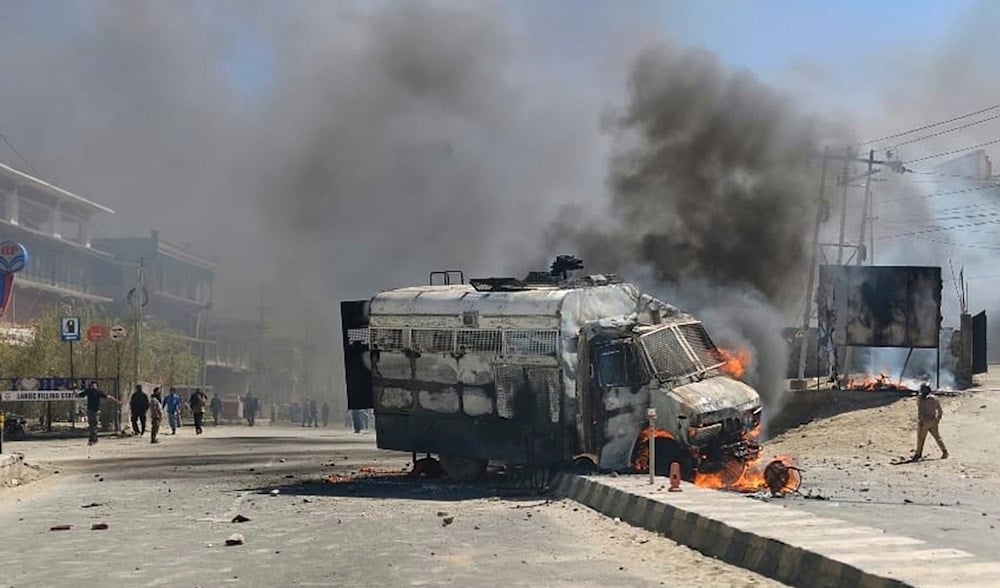India's Ladakh protests turn deadly: At least 5 killed, 70 injured
Deadly protests broke out in Ladakh’s Leh after hunger strikers were hospitalized during the statehood movement.
-

A police vehicle is set on fire during a protest by locals demanding federal statehood from the Indian government, in the high-altitude Leh town, in the region of Ladakh, India, Wednesday, September 24, 2025. (AP)
The Himalayan region of Ladakh is of crucial strategic importance to India’s national security, with China to its east and Pakistan to its west. Since 2019, however, it has been under direct central government control, fueling resentment among many residents.
On Wednesday, that anger erupted into deadly protests in Leh, the region’s largest city, after two hunger strikers were hospitalized. Clashes between demonstrators and police escalated into violence, leaving several dead and dozens injured, according to The Washington Post.
According to Chering Dorjay, co-chairman of the Leh Apex Body, at least five protesters were killed and around 70 were injured, WashPo wrote. India’s Ministry of Home Affairs confirmed “some casualties” but did not specify numbers, adding that more than 30 police and security personnel were also injured.
The government said security forces had fired in self-defense after protesters attacked and set fire to property. Local leaders said demonstrators torched the office of the Bharatiya Janata Party (BJP), the ruling party of Prime Minister Narendra Modi.
One day of protest by youths in a far corner of India, in Ladakh. At least 4 killed, more than 70 injured by Modi’s police forces. It is not that Indians are not protesting but Indian forces, like Pakistani forces, are not with people but with the regime. pic.twitter.com/Guhkc1SYSF
— Ashok Swain (@ashoswai) September 24, 2025
The trigger
The unrest followed weeks of a hunger strike led by Sonam Wangchuk, a well-known climate activist and face of the Ladakh autonomy movement. Wangchuk had been fasting for two weeks with a group of supporters, while hundreds joined in daily fasts.
On Tuesday, two strikers were hospitalized after their health deteriorated, triggering anger among younger protesters who began pelting stones and damaging buildings on Wednesday morning. “We tried hard to control them, but they just became uncontrollable,” Dorjay said.
The Indian government blamed Wangchuk for inciting unrest, pointing to his references to the Arab Spring and recent anti-corruption protests in Nepal. In response, Wangchuk denied responsibility and said he opposed violence, calling the clashes a “setback” to the Ladakh statehood movement.
Later on Wednesday, Wangchuk announced the end of his hunger strike.
This is not his first such action. In 2023, he and his supporters marched more than 700 kilometers from Leh to New Delhi, vowing to fast until talks resumed with the government. The next round of negotiations is scheduled for October 6.
Ladakh’s strategic importance
Ladakh was part of the former state of Jammu and Kashmir until 2019, when the Modi government revoked the region’s autonomous status. Jammu and Kashmir were given a local assembly, but Ladakh was placed directly under New Delhi’s rule.
Since then, its geopolitical importance has grown. In 2020, India and China fought deadly border skirmishes in Ladakh’s Galwan Valley, underscoring the region’s sensitivity. In 2024, India announced that it had reached an agreement with China regarding patrolling along the Line of Actual Control (LAC), marking a significant breakthrough in the four-year military standoff between the two nuclear-armed neighbors.
Indian Foreign Minister Subrahmanyam Jaishankar later confirmed that the two nations have reverted to the pre-2020 situation along the LAC, following clashes that resulted in the deaths of 20 Indian and four Chinese soldiers in July 2020.
The Ladakh autonomy movement argues that without statehood and constitutional protections, local communities risk losing land, jobs, and political representation, concerns that fueled Wednesday’s violent turn in Leh.
Read more: Indian army resumes patrols along disputed border with China

 3 Min Read
3 Min Read









